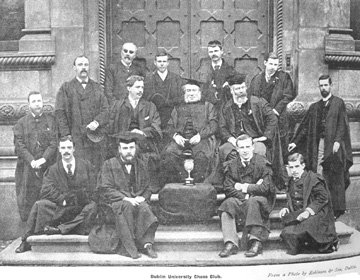This puts us up to 4th in table, great start to the season.
Oisin and myself got the wins, and there were a lot of hard fought draws too.
I've annotated my game, you can see it below:
[Event "Amstrong Cup 2011/12"]
[Date "2011.10.18"]
[White "Lyons, Brendan"]
[Black "Moran, Stephen"]
[Result "0-1"]
[WhiteElo "1848"]
[BlackElo "1991"]
1. e4 e6 2. d3 d5 3. Nd2 Nf6 4. Ngf3 c5 5. g3 Nc6 6. Bg2 Be7 7. O-O O-O 8. Re1
b5 9. e5 Nd7 10. h4 a5 11. Nf1 Ba6 12. Bf4 b4 13. N1h2 (13. Ne3) 13... a4 14.
Ng5 (14. a3 {is an interesting try to hold black on the queenside.}) 14... Qe8
{All theory up to here.}
 |
| 14...Qe8 |
15. Qh5 {probably not best, as it walks into the
point of black's 14th move.} (15. c4 bxc3 16. bxc3 h6 17. Ngf3 Qc8 18. Ng4 Rb8
{is another interesting line, but you have to be brave to allow so many pieces
aim at at your kingside, particularly h6.}) 15... Bxg5 (15... h6 16. Ng4 {gets
a bit crazy. Black has to defend accurately.} Bxg5 (16... hxg5 17. hxg5 Qd8 18.
Be4 dxe4 19. Kg2) 17. hxg5 f5 18. Qxe8 Raxe8 19. Ne3 hxg5 20. Bxg5 Ncxe5 {with
a slight advantage.}) 16. hxg5 f5 {this is point behind Qe8. White doesn't
have time to play exf6 because his queen is attacked. If he swaps off the
queens, black has much the better prospects on the queenside.} 17. Qh4 {
leaving the queen out of play.} (17. Qd1) 17... Nd4 {this is always annoying
for white without the queen around to defend the weak pawns.} 18. Rac1 b3 19.
axb3 axb3 20. c4 (20. c3 Nc2 21. Red1 Nb6 {none of white's pieces are doing
anything. Black can attack the queenside pawns or try invade down the a-file.})
20... dxc4 {I figured I could sacrifice the exchange here, since my bishop and
queen would line up along the h1-a8 diagonal and it would be a monster. I'd
also have Nd7-b6-c4 or a4 ideas too.}
 |
| 20...dxc4 |
21. dxc4 {probably best to decline the
offer.} (21. Bxa8 Qxa8 22. dxc4 Qc6 23. Rc3 {to play f3 after black plays Bb7.}
Bb7 24. f3 Ra8 25. Bc1 Ra1 {with roughly equal chances. I still like black's
activity though.}) 21... Rd8 22. Nf3 Nb6 23. g6 {white missed my 25th move
when playing this.} (23. Be3 {keeps it level, or maybe even a small advantage
with the two bishops.} f4 (23... Nxc4 24. Nxd4 cxd4 25. Bxd4) 24. Bxd4 cxd4 25.
Nd2 fxg3 26. Qxg3 Qf7) 23... Qxg6 24. Bg5? (24. Nxd4 Rxd4 25. Qe7 Nd7 26.
Red1 Qf7 27. Qxf7+ Kxf7 {is only slightly better for black.}) 24... Nxf3+ 25.
Bxf3 Rd4 {and black is a clear pawn up with a better position.}
 |
| 25...Rd4 |
26. Qh5 Qxh5
27. Bxh5 Nxc4 {finally the weak pawn goes.} 28. Be7 (28. Be2 Nxe5 29. Bf4 Nc4
30. Bf1 Kf7 31. Rc3 h6 32. Ra1 Bb5 33. Rxb3 {and despite being a pawn up, it's
not easy for black.}) 28... Rc8 29. Ra1 (29. Rc3 {to pick up the b3 pawn is
better.}) 29... Bb7 {the bishop is a monster here, white has to watch out for
back rank mates now.} 30. Ra7 Rd7 (30... Bd5 {consolidates everything quicker
and protects the b3 pawn. White has no threats.}) 31. Bd6 Nxb2 {creating
connected passed pawns.}
 |
| 31...Nxb2 |
32. Rb1 c4! {a nice way to finish the game, by
marching a pawn up the board.} 33. Rxb2 c3 34. Rxb3 c2 35. Ba3 c1=Q+ 36. Bxc1
Rxc1+ ({White resigned bacause of the following} 36... Rxc1+ 37. Bd1 Rcxd1+ 38.
Kh2 Rh1# {A triumph for the light squared bishop!}) 0-1
 |
| 38...Rh1# |
We've also started the tournament to see who could get on one of our teams. So far after 3 rounds the table looks like this:
Teams2011
DU Chess Soc - 20/10/2011, 20/10/2011
Cross Table at round 3
ID NAME Rtg T Fed Pts | 1 2 3
--------------------------------------------------------------
1 Enrique Saez 1700 NC --- 3.0 | +B10 +W15 +B3
2 Colin Power 1300 NC --- 2.0 | -W4 +B11 +W13
3 Diego Lionello 1300 NC --- 2.0 | +W13 +B9 -W1
4 Charles Dillon 1200 NC --- 2.0 | +B2 -W6 +B16
5 John Shanley 1100 NC --- 2.5 | =W17 +B8 +B6
6 Robert Murtagh 1000 NC --- 2.0 | +W11 +B4 -W5
7 Andy Hare 0 NC --- 0.0 | -- -- --
8 Brian McDonald 0 NC --- 1.5 | =B15 -W5 +B10
9 Diarmuid Neville 0 NC --- 2.0 | +B16 -W3 +B17
10 Eric Hattaway 0 NC --- 0.0 | -W1 -B13 -W8
11 Ewan Dalby 0 NC --- 1.0 | -B6 -W2 +BYE
12 John Prasifka 0 NC --- 0.0 | -- -- --
13 Michael Birt 0 NC --- 1.0 | -B3 +W10 -B2
14 PJ Moloney 0 NC --- 0.0 | -- -- --
15 Philip Corkery 0 NC --- 0.5 | =W8 -B1 -BYE
16 Sean Delorey 0 NC --- 1.0 | -W9 +B17 -W4
17 Sean Higgins 0 NC --- 0.5 | =B5 -W16 -W9
Can anyone catch Enrique?? He's looked very strong so far. It's not too late to put yourself in the hat, we'll be continuing next week and maybe one more week after that. Let me know if you'd like to play.
Oh, and a quick reminder that our library is open to your viewing on the right hand side of the page.
That's it for this week,
Stephen









